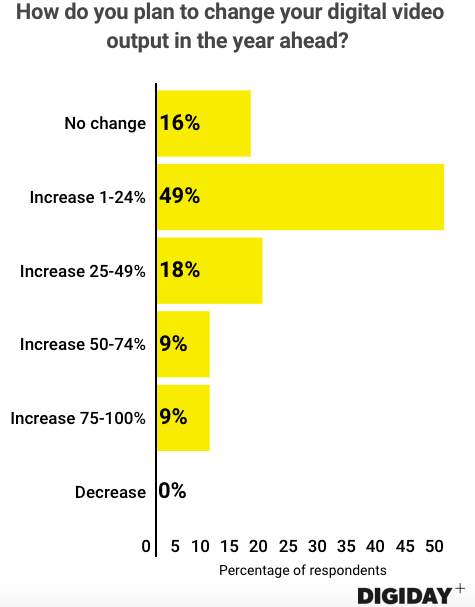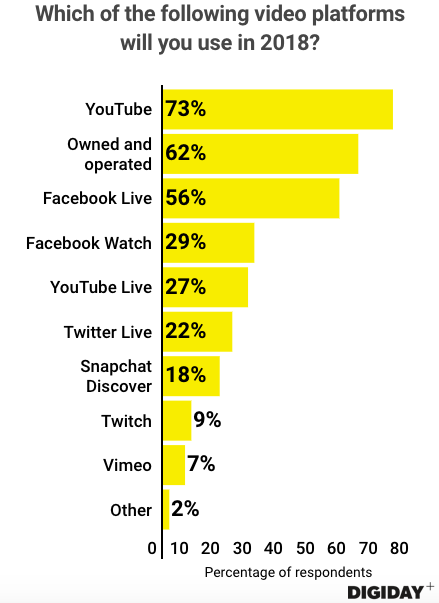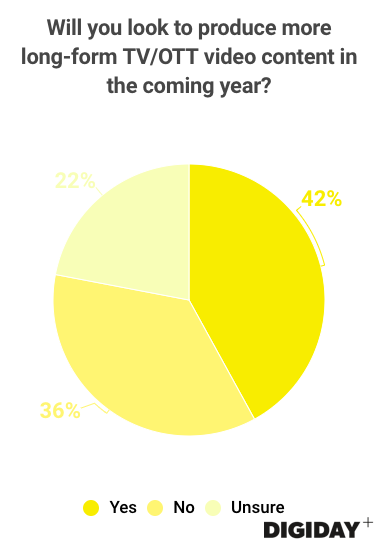Digiday Research: 86 percent of publishers plan to increase their video production

This research is based on unique data collected from our proprietary audience of publisher, agency, brand and tech insiders. It’s available to Digiday+ members. More from the series →
At the Digiday Publishing Summit last month in Vail, Colorado, we surveyed representatives from 49 publishers to learn about their video strategies. Check out our earlier research on C-suite publisher executives’ mixed feelings about Facebook here. Learn more about our upcoming events here.
Quick takeaways:
- Since September 2017, the percentage of publishers that plan to boost their video production has slightly increased, according to Digiday’s survey.
- Publishers favor YouTube to distribute their videos.
- Forty-two percent said they plan to produce TV or OTT content in the coming year.
Publishers plan to produce more video
Undeterred by the challenges facing video-centric publishers like Mashable, Oath, LittleThings and Cooking Panda, more U.S. publishers plan to increase the number of videos they produce. Eighty-six percent of publishers surveyed at last month’s summit indicated they plan to increase their videos output in the year ahead, a slight uptick from 84 percent in October 2017.

For publishers that failed in their attempts to pivot to video, two main factors contributed to their demise: Facebook’s deprioritization of publishers in its news feed resulted in a drop in their video views; secondly, many publishers generate most of their video views on social platforms and those views are notoriously difficult to monetize.
As publishers continue producing digital videos, their expectations around potential revenue and business opportunities must be realistic. As one participant from the Digiday Publishing Summit in March put it: “We just have to set expectations. If you want to be on the top 100 sites on the internet, there is only a quantifiable amount of inventory, and it’s not going to be $8 [CPMs].”
Publishers favor YouTube to host videos
YouTube is the clear favorite platform to host and distribute publishers’ videos ahead of publishers’ owned sites, according to Digiday’s survey, which found that nearly three-quarters of publishers will put their videos on YouTube in 2018.

Publishers make more of their digital video ad revenue on their owned and operated websites than on YouTube, according to Digiday’s earlier research. However, ad revenue isn’t necessarily publishers’ motivation when distributing videos on platforms, with over half of publishers in previous Digiday research saying that reaching new audiences was their primary objective for distributed video. That makes YouTube, with 1.5 billion logged-in monthly users, an obvious place to start for publishers.
Beyond scale, YouTube offers publishers benefits to post their videos to the platform, including the ability to directly sell the ads that will appear in front of their content. “We have gone all-in on YouTube because that has the best monetization path,” one publisher executive said.
Although Facebook no longer pays creators to produce Facebook Live videos, Digiday’s March survey found that 56 percent of publishers will use Facebook Live this year, and Socialbakers data from January found that 52 percent of the top 1,000 publishers posted a Facebook video in the last month. Facebook Live videos could potentially perform better after Facebook’s recent algorithm change because they get higher engagement than normal video posts by publishers to their pages.
Platform spending makes OTT attractive
With Netflix, Amazon, Hulu, HBO and CBS all planning to spend more than $1 billion in 2018 on original content, publishers like Vox, Fusion Media Group and Condé Nast Entertainment are producing OTT and TV content. Over 40 percent of publishers that Digiday surveyed say they plan to make long-form content for OTT and TV platforms.

Digitally native media companies such as NowThis, Cheddar, Ozy, Vox and BuzzFeed are already creating this content. At the Digiday Video Anywhere Summit in November, 96 percent of the publishers surveyed said they believe more digitally native media companies will create more OTT or TV content. Having failed in the pivot to digital video, publishers could now be pivoting to OTT and TV.
More in Media

Here are the biggest moments in AI for publishers in 2025
Here are some of the moments that defined how publishers adapted to the AI era this year.

Digiday+ Research roundup: Gen Z news consumption and diversification in the DSP space were 2025’s top trends
As 2025 winds down, we rounded up the biggest trends of the year, based on the data that resonated the most with Digiday’s readers.

What publishers are wishing for this holiday season: End AI scraping and determine AI-powered audience value
Publishers want a fair, structured, regulated AI environment and they also want to define what the next decade of audience metrics looks like.





